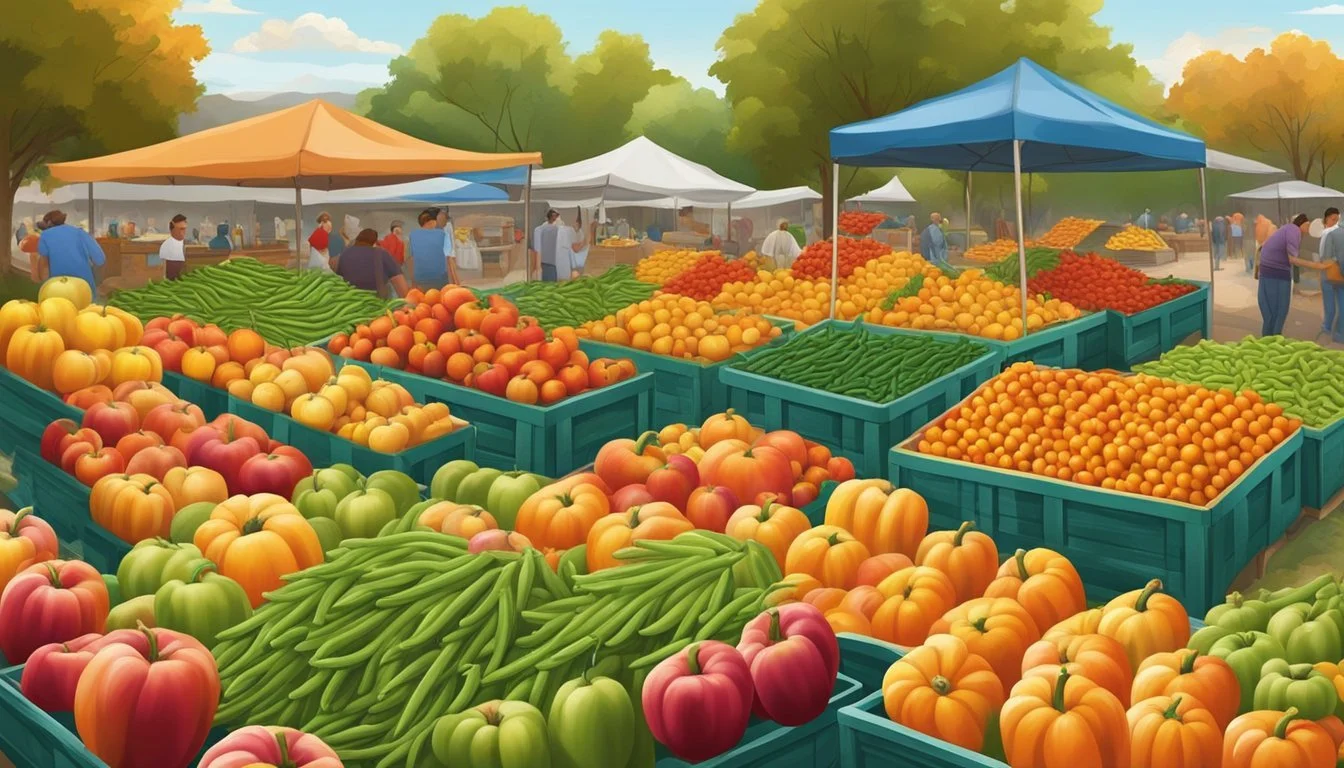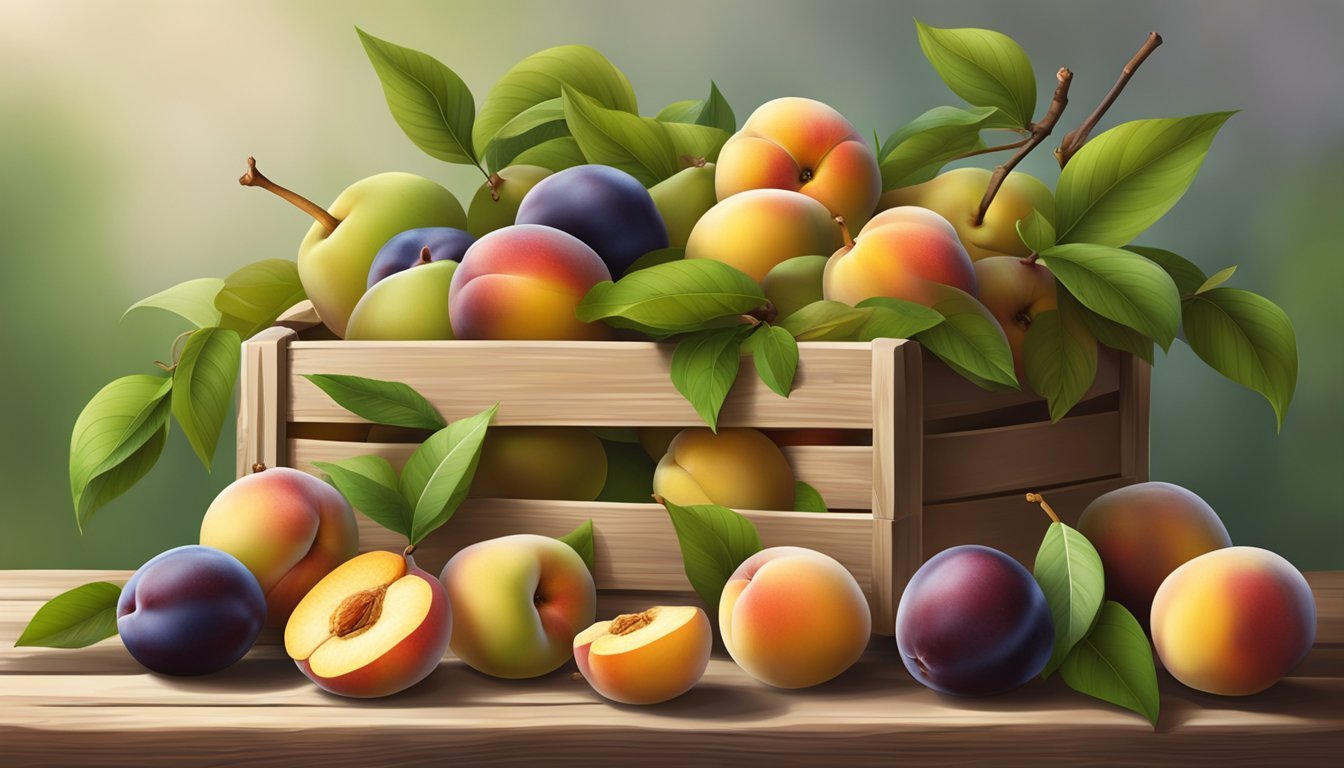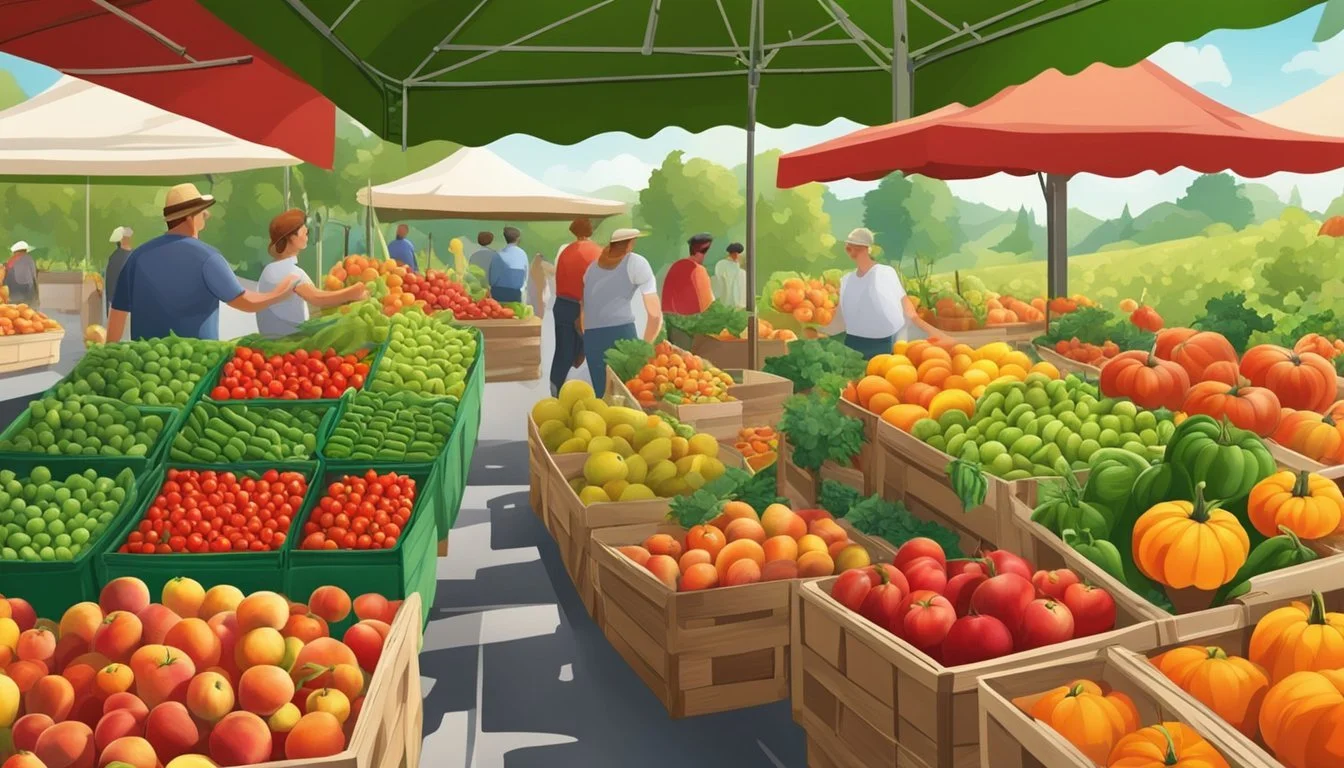Virginia Seasonal Fruit & Vegetables in September
Your Fresh Guide
This Article is Part of our Virginia Seasonal Fruit & Veg Calendar
September in Virginia heralds the transitional phase where the end of summer produce meets the first picks of fall harvest. This month is characterized by a diverse range of fruits (What wine goes well with fruit?) and vegetables that offer a unique blend of flavors, textures, and nutritional benefits. Virginia's climate and soil conditions during September provide an ideal environment for a variety of seasonal produce to thrive.
Fruits such as apples (how long do apples last?) and pears come into prime season, offering crisp and juicy options for both raw and cooked consumption. Apples, a fall staple, start to peak in their freshness, making them perfect for pies, ciders, and savory dishes. Vegetables like cauliflower and bell peppers maintain their summer quality while introducing a richer, more robust flavor profile as they mature into the cooler days of September.
In addition to the famed apples, Virginia's September harvest includes a bounty of vegetables that are vital to the local cuisine and economy. Leafy greens such as collard greens (how long do collard greens last?) continue their growth, providing a hearty base for soups and stews. While the summer's sweet corn and cucumbers make their final appearance, root vegetables and squashes begin to claim their spot in the markets, preparing consumers for the heartwarming meals associated with the approaching fall season.
Seasonal Overview
September in Virginia marks a transitional period where the warmth of summer yields to the crisp beginnings of fall. This shift brings about a diverse array of produce ripe for harvesting. Consumers can delight in the confluence of both summer and fall fruits and vegetables that are in season during this month.
Fruits available are typically the last vestiges of summer and the first hints of fall. Apples emerge as a staple, with a variety of types reaching their peak, promising flavors from tart to sweet. Pears also enter the spotlight, providing a juicy, softer counterpoint to the crunch of apples.
The vegetable harvest is abundant, bridging summer favorites with the heartier selections of fall. One can find:
Bell peppers—adding a splash of color and sweet, piquant flavors to dishes.
Cucumbers—crisp and refreshing, winding down as the summer concludes.
Eggplants (What wine goes well with eggplant?)—with their glossy skins and versatile nature for culinary creations.
Collard greens—which start to sweeten as the cooler temperatures set in.
Moreover, root vegetables begin to make a more prominent appearance. The cooler soil tempers the earthy sweetness of beets (how long do beets last?), a nutritious and vibrant addition to the table.
This bounty reflects the state's agricultural richness and consumers' opportunity to enjoy fresh, local produce. By indulging in September’s seasonal offerings, one supports Virginia's farming community and partakes in the freshest flavors available.
Fruits in Season
September in Virginia marks a bountiful period for fruit harvests, with an array of flavors ranging from sweet to tart. This is an ideal time for fruit enthusiasts to explore the variety of local produce available.
Apples
Virginia orchards offer a diverse selection of apples in September. Varieties like Honeycrisp and Gala provide a sweet flavor, while Granny Smith offers a tart alternative for those who prefer a zing. They are ideal for both eating fresh and culinary uses, depending on one's preference for sweetness or acidity.
Berries
By September, the berry season is winding down, but there can still be late-harvest berries available such as raspberries. These small fruits pack a flavorful punch and are perfect for jams, desserts, or simply fresh off the bush.
Grapes
Vineyards in Virginia are busy in September with grape harvests. Table grapes like the Concord variety are ripe and ready to eat, characterized by their bold, sweet taste. Wine grapes are also reaching maturity, destined for fermentation into Virginia's renowned wines.
Pears
Pears, particularly the Bartlett and Anjou varieties, come into season in September. These pears range in flavor from sweet to subtly tart and have a buttery texture. They can be eaten fresh or can add a juicy component to baked goods and salads.
Stone Fruit
Stone fruits are nearing the end of their season in September, but peaches can still be found. The lingering stone fruit harvest brings with it a sweet, succulent flavor profile, a perfect addition to Virginia's autumnal bounty.
Vegetables in Season
In Virginia, September marks the transition from summer to autumn, bringing a harvest rich in variety and flavor. This is a prime month for many vegetable crops, ensuring a bountiful and diverse selection.
Leafy Greens
September sees an abundance of leafy greens. Kale and collard greens thrive during this time, offering a nutritious addition to meals. Their hardy leaves are perfect for sautéing or adding to hearty soups.
Root Vegetables
The cooler temperatures of September encourage the growth of root vegetables. Radishes and sweet potatoes are especially plentiful. Known for their earthy flavors and versatile use in both savory and sweet dishes, these vegetables become kitchen staples.
Squash Varieties
A variety of squash is ready for harvest in September. One can find both summer and winter squashes, including the likes of zucchini and butternut squash (how long does butternut squash last?). They can be roasted, pureed, or used in baking, providing both texture and a slight sweetness to dishes.
Nightshades
Nightshade vegetables such as tomatoes, eggplant (What wine goes well with eggplant?), and peppers are still in season during early September. They are perfect for grilling or adding to fresh salads, and the range of heat in peppers from mild to fiery allows for a wide breadth of culinary uses.
Common Harvesting Practices
In September, Virginia's harvest practices reflect the diversity of crops available. Farmers and gardeners prioritize different techniques to ensure the produce is at its peak when picked.
For fruits like apples, which should be firm and crisp, growers look for the golden hue indicating ripeness. A gentle twist-off technique is used to pick apples to avoid bruising. Apples that exhibit the appropriate firmness are then either sent to markets or stored in a fridge to maintain freshness.
Root vegetables, such as beets, are harvested when they are firm and of a round shape, indicating maturity. Harvesters gently loosen the soil around the plant to pull the root out without damage.
Greens, on the other hand, require a delicate approach. Leaves should be tender and vibrant in color. Farmers typically hand-pick these leaves early in the day to ensure the leaves remain crisp, often before the heat softens them.
Below is an outline of the harvesting indicators for September crops in Virginia:
Apples: Golden hue, firm to the touch, twist-off method
Beets: Firm, round shape, loosened soil harvest
Leafy Greens: Tender, vibrant color, morning harvest
Harvesters also watch for the optimal size and color of other vegetables and fruits, indicative of peak flavor and texture, to determine the right moment for harvest. Proper harvesting ensures the produce reaches the consumer in the best possible condition, making the most of September's bountiful offerings.
Fresh Preparation Ideas
In Virginia, September's harvest offers a rich tapestry of fruits and vegetables ideal for a range of fresh preparations. Home cooks can take advantage of the seasonal abundance with confidence and creativity. Apples, a quintessential fall fruit, are perfect for making homemade applesauce—a simple yet satisfying treat.
For vegetables like chiles and bell peppers, achieving bold flavors can be as easy as giving them a quick fry. They lend themselves well to lively salads or as accompanying garnishes adding a burst of color and heat to any dish. Collard greens and escarole, with their robust leaves, are ideal for steaming, which preserves their nutritional value and brings out a subtle, earthy flavor.
When it comes to seasonal fruits, apart from creating a sweet applesauce, consider crafting a fruit salad that melds the tastes and textures of September’s offerings. Apples, paired with late-summer pears and berries, can offer a delightful contrast to the palette of flavors found in vegetable-centric dishes.
Cucumbers and fennel (how long does fennel last?), with their crisp texture and refreshing taste, are excellent additions to salads. The distinct anise-like flavor of fennel (how long does fennel last?) can also be a flavorful surprise in soups that cater to cooler evenings.
Here's a simple guide that showcases how to best enjoy these seasonal delights:
Fruit/Vegetable Preparation Method Dish Suggestion Apples Homemade Sauce Applesauce Chiles Frying/Salads Fried Chiles Salad Collard Greens Steaming Steamed Greens Cucumbers Fresh/Salads Cucumber Salad Fennel Fresh/Salads/Soups Fennel Soup
When exploring these fruits and vegetables, always strive for the freshest produce to ensure peak flavor and nutrition.
Preserving the Harvest
In September, Virginia's bounty of fruits and vegetables can be preserved for enjoyment year-round. Home preservation is a practical way to extend the life of the season's produce. Here are techniques and tips tailored to some of September's offerings:
Canning: Tomatoes are abundant in September and perfect for canning. They can be preserved as sauces, salsas, or whole fruit. Canning involves sterilizing jars and food through boiling, sealing them to prevent spoilage.
Tomato Sauce Recipe:
Ingredients: Fresh tomatoes, onions, garlic, herbs, and seasoning.
Process: Cook down the ingredients, pour into sterilized jars, and process in a water bath.
Freezing: Peppers and green beans freeze well. Blanching vegetables before freezing ensures they retain their color, flavor, and nutritional value.
Freezing Method:
Wash, trim, and slice.
Blanch in boiling water briefly.
Cool immediately in ice water.
Dry and pack into freezer bags or containers.
Drying: Herbs like basil and chives (how long do chives last?) are perfect for drying. They can be air-dried or dehydrated and stored in airtight containers.
Drying Herbs:
Wash and pat dry.
Tie in small bunches and hang in a warm, dry space.
Pickling: Cucumbers and other vegetables can be pickled for a tangy treat. The pickling process involves vinegar and canning for long-term storage.
Pickled Cucumbers Recipe:
Ingredients: Cucumbers, vinegar, water, pickling salt, dill, and spices.
Process: Combine vinegar, water, and seasonings to make brine. Pour over cucumbers placed in jars and process.
Preserving the harvest allows one to savor the lushness of Virginia's September produce for months to come. Each method retains the flavors and nutritional benefits of the produce, ensuring that they have access to local flavors outside their typical seasons.
Nutritional Information and Health Benefits
In September, Virginia's produce offerings are abundant, providing a wealth of nutritional benefits. These fruits and vegetables are typically at their peak, offering maximum flavor and nourishment.
Apples, available in various varieties, are a sweet and crunchy source of dietary fiber, vitamin C, and various antioxidants. Eating apples is associated with a lowered risk of chronic diseases such as heart disease, diabetes, and cancer.
Eggplant, with its spongy texture, is low in calories but rich in fiber, vitamins B1 and B6, and the mineral potassium. It contains nasunin, a unique compound with antioxidant properties that protect brain cell membranes.
Cucumbers are mostly water, which helps hydration. They provide vitamin K, necessary for bone health, and fisetin, which has shown potential in supporting brain health.
Greens, such as escarole, offer a slightly bitter taste and are loaded with vitamins A, C, and K, folate, and fiber. They support eye health, immune function, and may reduce inflammation.
Pumpkin is not just for decoration; it's a sweet and hearty vegetable high in vitamins A and C, promoting healthy skin and immune system. It also contains fiber, which aids digestion and satiety.
Below is a nutritional highlight of these foods:
Food Item Key Nutrient Health Benefit Apples Vitamin C, Fiber Reduces disease risk, aids digestion Eggplant Fiber, Vitamins B1, B6 Antioxidant, brain health support Cucumbers Vitamin K, Fisetin Bone health, supports brain health Escarole Vitamins A, C, K Immune support, reduces inflammation Pumpkin Vitamin A Supports immune system, healthy skin
These seasonal foods contribute a range of sweet flavors and essential nutrients to one's diet. Integrating them into regular meals can enhance overall health and nutrition.
Buying and Storing Tips
When purchasing seasonal fruits and vegetables in Virginia during September, one should prioritize freshness and ripeness. For example, Brussels sprouts (how long do brussels sprouts last?)are in season and should appear vibrant green without yellowing leaves. They store best when removed from the stalk and kept in a loose bag in the fridge where they can last several weeks.
Apples, a fall staple, hit their peak this month. One should look for firm, bruise-free apples and store them in a cool, dark place. In proper storage, apples can maintain their quality for weeks.
Butter beans should be plump and firm when bought fresh. They can be kept in the refrigerator for up to a week or can be frozen after blanching for longer shelf life.
Tomatoes, still available in September, should be purchased when their color is even and they have a slight give when gently pressed. They ripen best at room temperature away from sunlight and should be used when they reach desired ripeness to enjoy their full flavor.
For cantaloupes (how long does cantaloupe last?), one looks for symmetrical melons free of cracks. A ripe cantaloupe will have a fragrant smell at the stem end and should be stored in the refrigerator to slow down the ripening process. Cut cantaloupe needs to be covered and can last up to five days in the refrigerator.
Fruit/Vegetable Selection Tip Storage Location Shelf Life Brussels Sprouts Bright green, firm Refrigerator (loose bag) Several weeks Apples Firm, no bruises Cool, dark place Several weeks Butter Beans Plump, firm Refrigerator or freeze after blanching Up to a week (fresh), months (frozen) Tomatoes Even color, slight give Room temperature Use when ripe Cantaloupes Symmetrical, fragrant at stem Refrigerator Up to 5 days (cut)
By following these storage recommendations, consumers can ensure the longevity and optimal taste of their produce throughout the season.
Impact on Local Economy and Environment
Eating locally grown fruits and vegetables in September has a significant impact on Virginia’s economy and environment. First, the local economy benefits as consumers purchase directly from area farmers, which in turn supports local businesses and maintains farming livelihoods. Money spent within the community can circulate more times, often referred to as the 'local multiplier effect.' This economic activity can lead to job creation and more stable regional economies.
The environmental impact of consuming local produce is equally important. By choosing local, seasonal produce, like apples, beets, and broccoli, consumers can help reduce greenhouse gas emissions that result from long-distance food transportation. This also lessens the need for extensive packaging and the energy used for storage and freight.
Here are some staples of Virginia’s September produce and their benefits:
Apples: Fewer food miles, leading to reduced carbon footprint.
Asian Pears: Minimal storage required when bought locally.
Broccoli & Cabbage: Grown and harvested in close proximity, which means fresher produce.
Seasonal, local eating is a sustainable choice. It encourages reduced dependence on non-renewable resources and supports agricultural practices more attuned to Virginia's environment. When agricultural diversification is promoted, it leads to better soil health and biodiversity, benefits crucial for long-term sustainability.
By integrating seasonal, locally-grown fruits and vegetables into their diets, Virginians not only play a role in facilitating sustainable development but also actively contribute to the region's ecological well-being.











